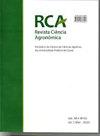An analysis of spatial dispersal in Ceratitis capitata in an orchard of the 'Palmer’ mango using McPhail traps
IF 0.7
4区 农林科学
Q3 AGRICULTURE, MULTIDISCIPLINARY
引用次数: 0
Abstract
- Th e aim of this study was to analyse patterns of spatial dispersal in Ceratitis capitata using two types of attractive traps and propose a predictive model of pest dispersal with the aim of determining management zones for decision-making. The experiment was conducted in an orchard of the ‘Palmer’ mango in the district of Belo Campo, Bahia. Sampling was carried out using McPhail and Jackson traps. The pattern of spatial dispersal in C. capitata was determined using the Perry and Mead Index of Dispersion, the Morisita Index, and the Local Moran index (LISA). The spatial variability of the abundance of C. capitata was obtained by geostatistical analysis, with the indicator kriging method used to prepare the location and spatial distribution maps. The Perry and Mead Index of Dispersion and the Morisita Index showed an aggregated pattern of spatial dispersal, whereas the Moran Local index showed a random pattern from 7 DFSH (days from the start of the harvest) to 35 DFSH, and an aggregated pattern at 42 DFSH. The SDI was strong at 7 and 35 DFSH and moderate at 14, 28 and 42 DFSH. The dispersal patterns of C. capitata allow an exponential predictive model to be produced, outlining strategies for exponential management zones of C. capitata , and detecting which places have the highest risk of the pest occurring.利用麦克菲尔诱捕器对“帕尔默”芒果果园中头角杆菌的空间分布进行分析
本研究的目的是利用两种类型的吸引陷阱分析头角虫的空间扩散模式,并提出害虫扩散的预测模型,目的是确定决策的管理区域。实验是在巴伊亚州贝洛坎波区的一个“帕尔默”芒果果园进行的。采用麦克菲尔诱捕器和杰克逊诱捕器取样。利用Perry and Mead弥散指数、Morisita指数和Local Moran指数(LISA)确定了柽桐的空间弥散格局。通过地统计学分析,获得了金针菇丰度的空间变异性,并采用指标克里格法编制了金针菇的位置分布图和空间分布图。Perry and Mead弥散指数和Morisita弥散指数表现为空间弥散的聚集型,Moran Local指数表现为7 ~ 35 DFSH的随机分布型,42 DFSH时为聚集型。7和35 DFSH时SDI较强,14、28和42 DFSH时SDI较弱。利用该方法建立了指数型预测模型,提出了指数型管理区域的策略,并对发生风险最高的区域进行了检测。
本文章由计算机程序翻译,如有差异,请以英文原文为准。
求助全文
约1分钟内获得全文
求助全文
来源期刊

Revista Ciencia Agronomica
Agricultural and Biological Sciences-Horticulture
CiteScore
2.00
自引率
0.00%
发文量
41
审稿时长
4-8 weeks
期刊介绍:
To publish technical-scientific articles and study cases (original projects) that are not submitted to other journals, involving new researches and technologies in fields related to Agrarian Sciences. Articles concerning routine analysis, preliminary studies, technical notes and those which merely report laboratorial analysis employing traditional methodology will not be accepted for publication. The Journal of Agronomical Science also has the mission to promote the exchange of experience in the referred fields.
 求助内容:
求助内容: 应助结果提醒方式:
应助结果提醒方式:


